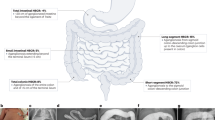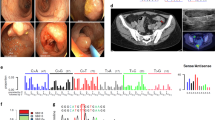Abstract
Hirschsprung disease (HSCR, aganglionic megacolon) is a common congenital malformation leading to bowel obstruction, with an incidence of 1/5,000 live births. It is characterized by the absence of intrinsic ganglion cells in the myenteric and submucosal plexuses along variable lengths of the gastrointestinal tract1. As enteric neurons are derived from the vagal neural crest, HSCR is regarded as a neurocristopathy2. On the basis of a skewed sex-ratio ( M/F = 4/1) and a risk to relatives much higher than the incidence in the general population, HSCR has long been regarded as a sex-modified multifactorial disorder3,4. Accordingly, segregation analysis suggested an incompletely penetrant dominant inheritance in HSCR families with agan-glionosis extending beyond the sigmoid colon3. We and others have mapped a dominant gene for HSCR to chromosome 10q11.2 and have ascribed the disease to mutations in the RET protoonco-gene5–8. However, the lack of genotype-phenotype correlation, the low penetrance and the sex-dependent effect of RET mutations supported the existence of one or more modifier gene(s) in familial HSCR9. In addition, thus far, RET mutations only accounted for 50% and 15–20% of familial and sporadic HSCR patients, respectively9–11. RET encodes a tyrosine kinase receptor whose ligand was unknown12. Recently, the Glial cell line- derived neurotrophic factor (GDNF) has been identified to be a ligand for RET13,14. Moreover, Gdnf−/− knockout mutant mice display congenital intestinal agan-glionosis and renal agenesis15–17, a phenotype very similar to the Ret −/− mouse18. These data prompted us to hypothesize that mutations of the gene encoding GDNF could either cause or modulate the HSCR phenotype in some cases.
This is a preview of subscription content, access via your institution
Access options
Subscribe to this journal
Receive 12 print issues and online access
$209.00 per year
only $17.42 per issue
Buy this article
- Purchase on Springer Link
- Instant access to full article PDF
Prices may be subject to local taxes which are calculated during checkout
Similar content being viewed by others
References
Rescorla, F., Morrison, A., Engles, D., West, K. & Grosfeld, J. Hirshsprung's disease. Evaluation of mortality and long-term function in 260 cases. Arch. Surg. 127, 934–942 (1992).
Bolande, R. The neurocristopathies ; A unifyng concept of disease arising in neural crest maldevelopment. Hum. Path. 5, 409–429 (1973).
Badner, J. & Chakravarty, A., Syndrome and Hirschsprung Disease : Evidence for pleiotropic effects of a single dominant gene. Am. J. Med. Genet. 35, 100–104 (1990).
Passarge, E. The genetics of Hirschsprung disease. N. Engl. J. Med. 276, 138–143 (1987).
Angrist, M. et al. A gene for Hirschsprung disease (megacolon) in the pericentromeric region of human chromosome 10. Nature Genet. 4, 351–356 (1993).
Lyonnet, S. et al. A gene for Hirschsprung disease maps to the proximal long arm of chromosome 10. Nature Genet. 4, 346–350 (1993).
Edery, P. et al. Mutations of the RET proto-oncogene in Hirschsprung's disease. Nature 367, 378–380 (1994).
Romeo, G. et al. Point mutations affecting the tyrosine kinase domain of the RET proto-oncogene in Hirschsprung's disease. Nature 367, 377–378 (1994).
Attié, T. et al. Diversity of RET proto-oncogene mutations in Hirschsprung's disease. Hum. Mol. Genet. 4, 2407–2409 (1995).
Yin, L. et al. Heterogeneity and low detection rate of RET mutations in Hirschsprung disease. Eur. J. Hum. Genet. 4, 821–830 (1994).
Angrist, M. et al. Mutation analysis of the RET receptor tyrosine kinase in Hirschsprung disease. Hum. Mol. Genet. 4, 821–830 (1995).
Takahashi, M., Buma, Y., Iwamoto, T., Inaguma, Y. & Ikeda, H. Cloning and expression of the ret proto-oncogene encoding a tyrosine kinase with two potential transmembrane domains. Oncogene 3, 571–578 (1988).
Durbec, P. et al. Glial cell line-derived neurotrophic factor signalling through the Ret receptor tyrosine kinase. Nature 381, 789–793 (1996).
Trupp, M. et al. Functional receptor for GDNF encoded by the c-ret proto-oncogene. Nature 381, 785–789 (1996).
Moore, M. et al. Renal and neuronal abnormalities in mice lacking GDNF. Nature 382, 76–79 (1996).
Pichel, J. et al. Defects in enteric innervation and kidney development in mice lacking GDNF. Nature 382, 73–76 (1996).
Sanchez, M. et al. Renal agenesis and the absence of enteric neurons in mice lacking GDNF. Nature 382, 70–73 (1996).
Schuchardt, A., D'Agati, V., Larsson-Blomberg, L., Costantini, F. & Pachnis, V. Defects in the kidney and enteric nervous system of mice lacking the tyrosine kinase receptor Ret. Nature 367, 380–383 (1994).
Schindelhauer, D., Schuffenhauer, S., Gasser, T., Steinkasserer, A. & Meitinger, T. The gene coding for glial cell line derived neurotrophic factor (GDNF) maps to chromosome 5p12-p13.1. Genomics 28, 605–607 (1995).
Richard, I. & Beckmann, J. How neutral are synonymous codon mutations? Nature Genet. 10, 259 (1995).
Lin, L., Doherty, D., Lile, J., Bektesh, S. & Collins, F. GDNF: a glial cellline-derived neurotrophic factor for midbrain dopaminergic neurons. Science 260, 1130–1132 (1993).
Oppenheim, R. et al. Developing motor neurons rescued from programmed and axotomy-induced cell death by GDNF. Nature 373, 344–346 (1995).
Emanuel, B., Padorr, M. & Swenson, O. Mongolism associated with Hirschsprung's disease. J. Pediat. 66, 437–439 (1965).
Passarge, E. Wither polygenic inheritance: mapping Hirschsprung disease. Nature Genet. 4, 325–326 (1993).
Kajiwara, K., Berson, E. & Dryja, T. Digenic retinis pigmentosa due to mutations at the unlinked peripherin/RDS and ROM1 loci. Science 264, 1604–1607 (1994).
Puffenberger, E.G. et al. A missense mutation of the endothelin-B receptor gene in muitigenic Hirschsprung's disease. Cell 79, 1257–1266 (1994).
Amiei, J. et al. Heterozygous endothelin receptor B (EDNRB) mutations in isolated Hirschsprung disease. Hum. Mol. Genet. 5, 355–357 (1996).
Edery, P. et al. Mutation of the endothelin-3 gene in the Waardenburg-Hirschsprung disease (Shah-Waardenburg syndrome). Nature Genet. 12, 442–444 (1996).
Hofstra, R. et al. A homozygous mutation in the endothelin-3 gene associated with a combined Waardenburg type 2 and Hirschsprung phenotype (Shah-Waardenburg syndrome). Nature Genet 12, 445–447 (1996).
Daub, H., Weiss, F., Wallasch, C. & Ullrich, A. Role of transactivation of the EGF receptor in signalling by G-protein-coupled receptors. Nature 379, 557–560 (1996).
Author information
Authors and Affiliations
Rights and permissions
About this article
Cite this article
Salomon, R., Attié, T., Pelet, A. et al. Germline mutations of the RET ligand GDNF are not sufficient to cause Hirschsprung disease. Nat Genet 14, 345–347 (1996). https://doi.org/10.1038/ng1196-345
Received:
Accepted:
Issue Date:
DOI: https://doi.org/10.1038/ng1196-345
This article is cited by
-
Comprehensive characterization of the genetic landscape of familial Hirschsprung’s disease
World Journal of Pediatrics (2023)
-
Genetic background-dependent abnormalities of the enteric nervous system and intestinal function in Kif26a-deficient mice
Scientific Reports (2021)
-
“Too much guts and not enough brains”: (epi)genetic mechanisms and future therapies of Hirschsprung disease — a review
Clinical Epigenetics (2019)
-
Hirschsprung’s disease: clinical dysmorphology, genes, micro-RNAs, and future perspectives
Pediatric Research (2017)
-
Traditional and targeted exome sequencing reveals common, rare and novel functional deleterious variants in RET-signaling complex in a cohort of living US patients with urinary tract malformations
Human Genetics (2012)



